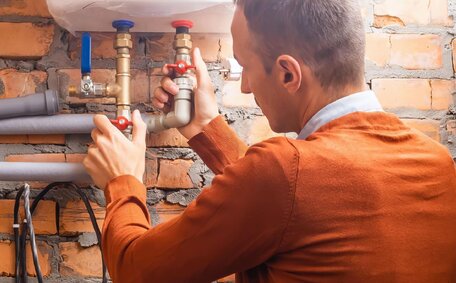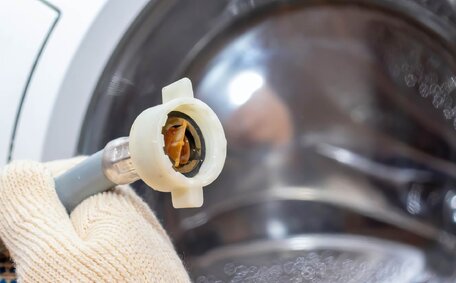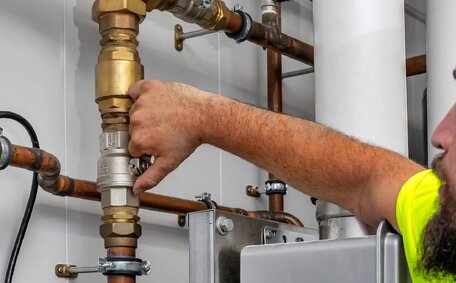Understanding the Gas Line Installation Process
A new gas line installation enables the use of natural gas for essential home appliances such as water heaters, stovetops, and ovens. The core stages of the installation process include:
- Planning - The licensed gas fitter will evaluate your needs, inspect the site for your natural gas line, and devise an ideal routing for effective gas distribution.
- Permits - Most areas require permits before starting gas work, which the gas fitter will secure.
- Pipe Laying - The gas fitter will excavate trenches and lay gas pipes, following legislative requirements, before connecting them to the gas main.
- Testing - Pressure tests are conducted carefully to ensure the gas systems are leak-free, thus protecting your household.
- Completion - The final phase includes completing the necessary paperwork, turning on the gas supply, and starting up the appliances.
The gas plumber directs the entire operation, guaranteeing the gas your home business depends on is installed impeccably. Timeframes vary depending on factors like the pipe layout complexity, permits, and appliances installed but usually take 1-5 days. Our team will assess and fulfil your gas requirements with a tailored solution.
Key Factors that Impact Installation Time
Several key factors influence the duration of a residential gas line installation project:
Complexity
Complex layouts result in longer installation times. Factors affecting complexity may include:
- The number of outlets and appliances requiring gas provisions
- Need for new gas metre location
- Routing pipes through walls/floors
Permits
Obtaining the essential permits for gas connected your residence may take from a few business days to several weeks, depending on local council processing durations, which could postpone the project.
Trenching
External pipe installation requires trenching, adding time for excavation, pipe placement, and terrain restoration.
Inspections
Mandated safety inspections by the Australian gas networks authority, a vital part of our plumbing services, are necessary for updates, which can briefly pause work.
Standard installations may take 1-3 days, while more complex projects could exceed 5 days.
Location of Appliance - Indoor vs. Outdoor
The location of gas appliances, such as heaters, inside or outside your home can affect installation times due to venting needs:
Indoor Appliances
- May require additional venting for combustion gases
- Space restrictions could add complexity
- Electrician may be needed for connections
Outdoor Appliances
- No need for indoor venting
- Trenching likely required for gas pipes
- Weatherproof enclosures are installed
Proximity of Existing Utility Lines
Existing gas lines and underground utilities such as water or telecommunication cables can affect the installation schedule.
- Closer proximity to gas mains enables a more direct connection, often shortening project duration.
- Extending the gas service line across greater distances to reach the gas mains involves additional trenching, piping, and restorative work.
- Navigating around other buried utilities also introduces complexity to the layout and process.
For example, installing a new gas line directly from a main on your street often can be wrapped up within a singular day. Laying new gas connections over distances such as 50 metres to your boundary may take most of a week, accounting for additional trenching and restoring the landscape.
Our skilled crew works alongside reputable gas providers to determine the most advantageous spots on your property to install gas, ensuring optimal fulfillment of your needs before finalising the connection strategy and installation schedule.
Transitioning Appliance Types
When installing a new gas line for a heater installation, transitioning to natural gas appliances such as a tankless water heater involves extra steps that may extend the duration. Key factors include any gas installation specifics:
- New venting for combustion gases may be required to meet safety codes
- Appliance connections need adapting from the old to new setup
- Supply lines could require upsizing to deliver adequate gas volume to different units
- Testing and inspections still apply, involving coordination time
While similar appliance swaps may add just one extra day, Advanced technologies may occasionally lengthen the timeline, leading homeowners to assess potential cost savings with natural gas. Our experts evaluate your energy setup to establish achievable outcomes, especially when facing uncertain timelines.
Presence of Whole-House Water Shut-off
Gas line installation timelines can be influenced by whether there is an existing whole-house water shut-off valve, especially when appliance hookups involve the water infrastructure.
- If your residence lacks a gas shut-off valve, coordinating with the local water authority to safely install components is critical, but this can introduce delays.
- Alternatively, having the ability to shut off the valve simplifies isolating the water system onsite for faster transitions, such as installing a gas water heater or connecting gas cooking appliances.
- If no shut-off exists, the gas fitter may recommend installing one, clarifying how much does the addition cost, to avoid delays and simplify future plumbing work.
In properties aiming to ensure efficient gas heating installation without integrated shut-offs, our technicians plan appointments accordingly and highlight the benefits of adding this useful home feature.
Pre-Installation Preparations
Prior to installing new gas lines, it’s crucial to undertake necessary pre-installation steps for a smooth process in compliance with all regulations. These preparations can provide gas safety for your property and help avoid delays or issues down the track.
Permits & Paperwork
The gas fitter will manage and submit all paperwork to ensure permits comply with your local authorities’ regulations for gas line work. It is essential to secure permits before we do gas infrastructure projects and legally initiate the work.
Underground Utilities
A meticulous site inspection locates existing underground utilities such as water, electricity, and telecoms, enabling a gas professional to safely and strategically install the pipes. Markings clearly show the locations.
Materials & Equipment
In anticipation, our proficient technicians can coordinate with your gas retailer to manage all connection fees, acquire specialty parts with extended lead times, and prepare the requisite materials and tools for your distinctive installation.
With administrative tasks, planning, equipment checks, and safety measures handled, our gas fitter can concentrate on safely and efficiently executing the physical installation, ensuring connection to the gas networks.
Securing Required Permits
Drawing on our expertise, we ensure that getting gas line installed aligns with performing due diligence to secure the requisite permits for various types before work commences. The licenced gas fitter handles all paperwork, including gas meter fee considerations, and submits it to the local council on your behalf, ensuring compliance with regulations. Requirements vary across different council areas but often need details like the proposed pipe routing, number/type of appliances, safety considerations, and insurance provisions.
Permit approval timeframes can span from 1 business day to 6+ weeks, dictated by factors like council workloads and site complexity.
Quick approvals enable starting work promptly, while delays push out timelines. Quick approvals enable starting work promptly, while delays push out timelines. Rushed applications risk rejection and rework.
Once approved, our team ensures that permits for our clients are conspicuously placed on-site, adhering to regulations for the duration of establishing your gas connection. For our clients, we, as your chosen gas retailer, pledge to comply fully with all permissions, codes, and regulations to ensure legal safeguarding and superior outcomes. Maintaining positive relations with councils also smooths approvals for any future gas property upgrades or plumbing needs.
Marking Underground Lines
Identifying underground utilities is essential before starting any excavation for gas pipe installation. A licensed plumber is not only skilled in installation but also understands the critical nature of avoiding live cables during repair gas works, as mishaps can cause severe injuries, considerable damage, and service disruptions. Our licensed technicians, using specialised equipment and visual indicators, carefully determine the locations of underground assets.
Coloured markers or paint indicate the positions of gas lines and other services, marking where your meter will be installed.
Red indicates electrical lines, blue for water, orange for telecoms, yellow for gas, and green for sewer pipes. These markers provide diggers with clear visual cues for safe trenching by highlighting subsurface hazards. Any unclear or unidentified services also get manually probed for that extra safety assurance before machinery starts ripping open the earth.
Carefully identifying subsurface networks is critical for secure gas line installation and reducing the risk of accidents, damages, fines, and delays. This simple step safeguards workers, maintains vital infrastructure integrity, and ensures our installation team can efficiently progress in excavating trenches before laying your new gas line safely.
Average Installation Time Estimates
Gas line installation Installation timeframes depend on various factors, with typical installations spanning 1-5 days. Here are average estimates:
Timeframes can vary with additional complexities such as installing new appliances, prompting our offer of customised solutions. We provide firm quotes accounting for all unique project variables. Get in touch with us to discuss your gas line installation needs.
Post-Installation Safety Checks
After gas line connection, our licensed technicians will conduct comprehensive leak tests and ensure all fittings comply with stringent safety standards. This concluding phase of gas services commissioning encompasses:
- Gas leak detection - Techniques such as electronic, acoustic, and soap bubble tests are used to identify any leaks, indicated by the tell-tale rotten egg smell.
- Ventilation - Confined areas receive ventilation compliance sign-offs.
- Documentation - Certificates proving legal completion are issued.
Only qualified gas fitters can certify that installations comply with AS/NZ 5601 and AS/NZS 5263, ensuring client peace of mind. Committed to delivering reliable gas piping systems, our team is available to provide expert advice and safety information on gas line installation.






